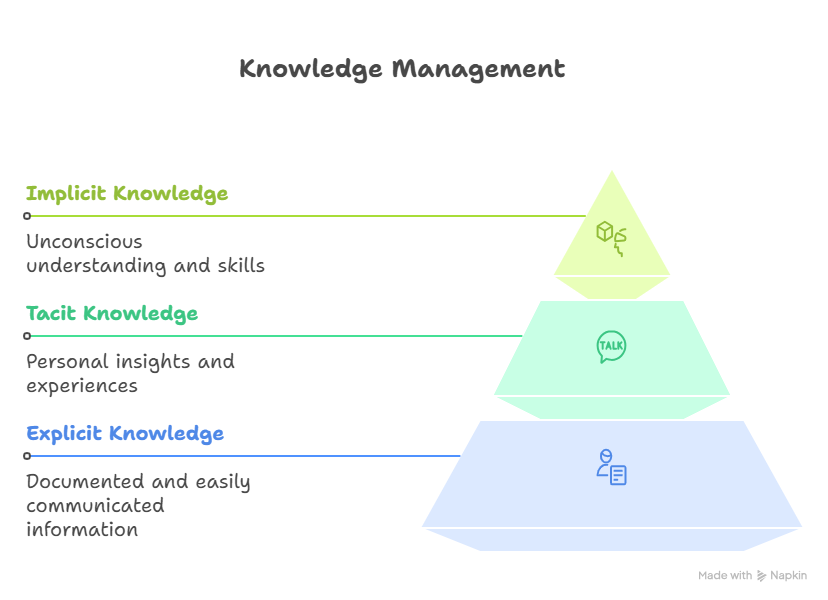Imagine this: your company's most competent employees just walked out the door. They took years of hard-won expertise, client relationships, and problem-solving know-how with them. Now you're scrambling to piece together what they knew.
This happens every day in businesses worldwide. The solution? Knowledge management.
We know what it takes to capture, organize, and share institutional knowledge. In this article, we go over everything you need to know about building a system that actually works.
Knowledge management is the systematic process of capturing, organizing, and sharing your organization's collective expertise. It's about ensuring that the correct information reaches the right person at the right time.
Think of it as your company's institutional memory. Instead of losing critical knowledge when employees leave or retire, you preserve it. Instead of teams reinventing solutions to problems others have already solved, they build on existing knowledge.
Knowledge management transforms scattered expertise into a strategic asset. It's the difference between starting from scratch every time and building on what you already know.
The business case for this is clear. Companies with effective knowledge management see measurable results:
- Faster project execution
- Reduction in time spent searching for information
- Improvement in employee onboarding speed
- Significant cost savings from avoiding repeated mistakes
These aren't theoretical benefits. They're real outcomes from organizations that get knowledge management right.

There are different types of knowledge management, and they are not equal or the same. Understanding the various types helps you build the proper capture and sharing strategies. The four types are:
- Explicit Knowledge
- Tacit Knowledge
- Implicit Knowledge
We go over them in detail below:
- Explicit knowledge lives in documents, databases, and formal procedures. It's easy to capture because it's already written down. Think user manuals, process documentation, and research reports.
- Tacit knowledge is more difficult to define. It's the expertise in your employees' heads, their intuition, judgment calls, and experience-based insights. A senior salesperson knows which prospects are worth pursuing. An experienced developer can spot code problems before they become critical bugs.
The challenge? Tacit knowledge walks out the door when people leave. You need deliberate strategies to capture it through interviews, shadowing programs, and storytelling sessions.
- Implicit Knowledge sits between tacit and explicit. It's knowledge that could be articulated if someone took the time to think through it, but hasn't been formally documented yet. Think of Unwritten rules about how meetings really work in your organization—informal networks of who to contact for different types of problems. Shortcuts and workarounds that experienced employees use but haven't shared. Cultural knowledge about timing, communication preferences, and decision-making patterns
In addition to the types of knowledge, knowledge management is roughly grouped into two kinds:
- Formal knowledge management
- Information knowledge management
Formal knowledge management uses structured systems, processes, and tools. You create databases, implement workflows, and assign ownership for knowledge areas.
Informal knowledge management happens naturally through conversations, mentoring, and communities of practice. The water cooler chat where someone shares a solution. The Slack thread where team members troubleshoot together.
The most effective approach combines both. Formal systems provide structure and searchability. Informal sharing keeps knowledge current and contextual.
A knowledge management system serves as the technology foundation for capturing, organizing, and sharing knowledge. It's not just a repository; it's a platform that makes knowledge in an organization accessible and actionable.
Your knowledge management system needs several key capabilities:
- Search and Discovery: People need to find information quickly and efficiently. An advanced search that understands context and relationships is more effective than basic keyword matching.
- Content Creation Tools: Make it easy for people to contribute knowledge. If the system is too complex to use, people won't use it.
- Access Controls: Not all knowledge should be available to everyone. You need granular permissions that strike a balance between security and accessibility.
- Integration Capabilities: Your knowledge management system should connect with existing tools. If people have to leave their regular workflow to access knowledge, they won't.
- Analytics and Reporting: You need visibility into what knowledge is being used, what's missing, and where gaps exist.
Enterprise platforms, such as SharePoint and Confluence, offer comprehensive features but require significant setup and ongoing maintenance.
Specialized Solutions: Tools like Notion, Guru, and Document360 focus specifically on knowledge management with user-friendly interfaces.
AI-Powered Systems: Modern platforms use artificial intelligence to automatically categorize content, suggest relevant information, and surface insights from your knowledge base.
To find a solution that meets your knowledge needs, choose one that aligns with your organization's size, technical capabilities, and specific requirements. A small team might thrive with a simple wiki, while a large enterprise needs enterprise-grade features..
Effective knowledge management follows a systematic process. Here's how it works:
Start by identifying valuable knowledge sources. Who are your subject matter experts? What processes are critical but undocumented? Where do people go when they have questions?
Create structured approaches for capturing knowledge:
- Exit interviews that focus on knowledge transfer, not just HR formalities
- Project retrospectives that document lessons learned
- Expert interviews that capture tacit knowledge before it's lost
- Process documentation that turns informal procedures into repeatable systems
The key is making capture part of regular work, not an additional burden.
Raw information isn't useful until it's organized and presented clearly and concisely. Develop taxonomies that make sense to your users; tag content with relevant metadata that is meaningful to them. Create clear naming conventions.
Think about how people actually search for information. They might look at:
- Topic or subject area
- Project or client
- Process or procedure
- Person or team
- Date or time period
Design your organization system to support these different search patterns.
Make knowledge discoverable. It means:
- Push strategies: Send relevant knowledge to people who need it. Weekly digests, project-specific resource lists, and proactive sharing based on current work.
- Pull strategies: Make it easy for people to find what they need when they need it, powered by a robust search, intuitive navigation, and clear content organization.
- Mobile access: People need knowledge outside the office. Ensure your system is compatible with various devices, including phones and tablets.
The ultimate goal is application. Knowledge that sits unused provides no value. Encourage use through:
- Training programs that teach people how to find and apply existing knowledge
- Integration with daily workflows so knowledge access becomes natural
- Feedback loops that improve knowledge quality based on actual use
- Success stories that demonstrate the value of using shared knowledge
Knowledge sharing doesn't happen automatically. You need intentional strategies to overcome natural barriers to sharing. Here is how you create a knowledge-sharing culture:
- Leadership sets the tone. When executives regularly share their own knowledge and give credit to others for sharing, it signals that knowledge sharing is valued.
- Make sharing visible. Recognize and reward people who contribute valuable knowledge. This doesn't have to be a formal or public acknowledgment; team meetings are often effective.
- Address the barriers. People worry about looking stupid, giving away a competitive advantage, or not having time. Address these concerns directly through communication and culture change.
A knowledge manager is your organization's champion for knowledge sharing and institutional memory. They're part librarian, part consultant, and part change agent.
The core responsibilities include developing knowledge strategies that align with business goals, designing and maintaining user-friendly knowledge management systems, curating content to ensure quality and accessibility, fostering a culture of knowledge sharing and collaboration, and providing training and support to help employees contribute to and benefit from these systems.
Technical competency: Understanding of knowledge management systems, search technologies, and content management approaches.
Communication skills: Ability to interview experts, facilitate discussions, and translate complex knowledge into accessible formats.
Change management: Experience helping organizations adopt new processes and technologies.
Business acumen: Understanding of organizational priorities and how knowledge management supports business objectives.
Analytical thinking: Ability to identify knowledge gaps, measure system effectiveness, and optimize knowledge flows.
Starting a knowledge management program requires careful planning and realistic expectations. Here's how to get it right.
Before you dive in, take stock of your current situation. What knowledge-sharing practices are already in place? Where are the most significant gaps? And what tools do people already use day to day?
It's usually best to start small. Pick one team, process, or knowledge area to pilot. See what works, learn from the challenges, and then scale up from there.
None of this will stick without leadership on board. Knowledge management requires ongoing investment and a cultural shift, so you'll need visible support from executives.
And finally, keep users at the forefront. Build your system around how people actually work, not how you wish they worked. The easier and more useful it is, the more likely people are to use it.
Knowledge management is the systematic process of capturing, organizing, and sharing your organization's collective knowledge and expertise. Your business needs it to prevent knowledge loss when employees leave, avoid repeating costly mistakes, improve decision-making, and accelerate the onboarding of new employees. Studies show knowledge management can increase business execution by nearly 40% in some companies.
Explicit knowledge is information that can be easily documented and shared, like manuals, reports, and procedures. Tacit knowledge refers to the harder-to-capture expertise in people's minds—their intuition, insights, and experience-based judgment. Both types are valuable, but tacit knowledge requires specialized techniques, such as interviews, shadowing, and storytelling, to be captured effectively.
The key is making knowledge sharing easy and showing clear value. Focus on resolving current pain points, such as difficulty finding information or duplicating work. Implement incentive programs that reward meaningful knowledge contributions, create casual spaces for informal sharing, and demonstrate how the system directly enhances employees' lives.
Start with knowledge that poses the highest risk if lost: critical processes, customer insights, technical expertise from key personnel, lessons learned from major projects, and institutional knowledge about company culture and decision-making. Prioritize knowledge that multiple people need access to and information that's frequently requested.
When implemented correctly, knowledge management actually reduces work by eliminating redundant efforts and making information more accessible. The key is integrating knowledge capture into existing workflows rather than creating separate tasks. Simple approaches, such as brief project summaries, shared folders, or quick knowledge base entries, can provide significant value with minimal time investment.
A knowledge manager is responsible for identifying, capturing, organizing, and facilitating the sharing of organizational knowledge. They design systems for storing information, bring people together for knowledge sharing, and ensure knowledge management initiatives succeed. While not every organization needs a full-time knowledge manager, someone should be assigned to this responsibility to ensure success.
Track both quantitative and qualitative metrics, including: knowledge base usage rates, time saved in finding information, reduction in duplicate work, employee satisfaction scores, new employee onboarding time, and business impact indicators. Regular surveys and feedback sessions help assess the quality and usefulness of shared knowledge.
You don't need expensive enterprise software to begin. Start with simple tools like internal wikis, shared document repositories, or collaboration platforms your team already uses. You can also use Skynet. As your program matures, you can invest in specialized knowledge management systems, AI-powered tools, or integrated platforms that offer advanced features such as automated categorization and intelligent search.
Build regular review and update processes into your knowledge management system. Assign knowledge owners for different content areas, set expiration dates for time-sensitive information, implement user feedback mechanisms, and create workflows for updating knowledge when processes change. Make updating knowledge as easy as creating it initially.
Yes, knowledge management is especially valuable for remote teams who can't rely on informal hallway conversations. Digital knowledge-sharing platforms, virtual communities of practice, and documented processes become critical for maintaining team cohesion and ensuring that everyone has access to necessary information, regardless of location or time zone.
